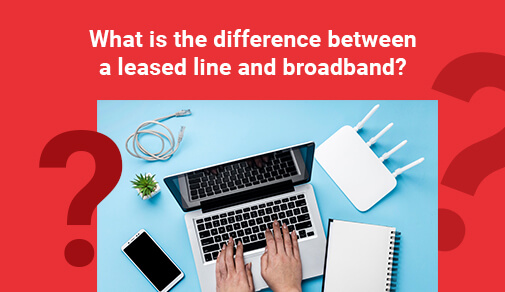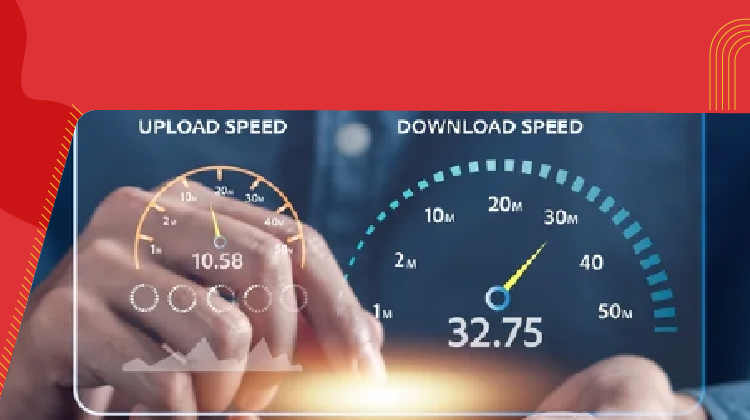What Is The Difference Between A Leased Line And Broadband?
Monday, Jun 07, 2021 · 5 minutes


LEASED LINE
Monday, Jun 07, 2021 · 5 minutes
When browsing for a new Internet provider, you'll likely be presented with a plethora of broadband packages and options. Business broadband with unlimited downloads, business broadband with a 1Gbps link, fibre broadband vs. conventional broadband, and so on. So what is the right course of action?
Leased lines and broadband both claim to be able to provide a high-speed internet connection for your business. However, there are variations between them that affect the pace you can achieve. Leasing lines are more stable because of these variations. However, the size of your network and the software you use will eventually determine if you can use a leased line or a broadband connection.
Broadband and leased lines vary in seven main ways:
A leased line connects the company to the internet at lightning speed. It can be installed using either fibre optic cables or a wireless antenna. Roads must be dug up for the former so that the cable can be linked to your office. An antenna is mounted on the roof of your building for the latter.
Although the installation methods vary, the advantages are the same:
Can range from 100 megabytes per second (Mbps) to ten gigabytes per second (GB/s) (Gbps).
It's a lightning-fast network that's uncontended, meaning you're not sharing your link with someone else. As a result, it will never be slowed down by external factors.
It means that when you click on a website, it loads easily.
It's simple to reduce your bandwidth if you don't need it, or to increase it if you do.
Which means you can upload and download files at the same time.
Broadband internet, including leased cables, has a high-speed internet service. Since you had to disconnect your phone line in order to use it, it was dubbed narrowband. However, this is no longer necessary. Broadband is now always accessible.
Broadband comes in a variety of flavours:
Connects your business to the internet through fiber-optic cables.
Stands for asymmetric optical subscriber line, and it connects you to the internet via copper telephone lines.
Transmits communication from satellites to you through digital signals.
##BlogVASBanner##
Broadband, unlike a leased cable, is competitive. As a result, there's a fair chance that many other people will be using your link at the same time. This could have an effect on the real speeds you can achieve. On a leased cable, speeds are symmetric, but on broadband, they are asymmetric. This indicates that downloads are quicker than uploads.
Superfast speeds will be advertised on leased lines and broadband. On leased tracks, there is no denying it. Broadband, on the other hand, is not always reliable. Since you're on an uncongested network, if you buy a leased line with 20Mbps, that's the pace you'll always get. With broadband, though, you're more likely to get a slower speed than what you were promised. This is due to the fact that broadband operates on a congested network. As a result, your 25Mbps link can only be 20Mbps at times.
If you use your link alone or share it with those in the region is determined by contention. Leased lines operate on a network that is not overburdened. Since no one else is using it except you, your connection will not be slowed by other users in the region. Since broadband is congested, you must share your link with a number of other people. This will slow you down during rush hour.
The time it takes for an event to answer after you click on something is known as latency. If the latency is short, the action will take place quickly. The operation will take a little longer if the temperature is high. Latency is poor on leased tracks. It will not take long for a web page to load after you click on it. Broadband, on the other hand, has a longer latency.
Scalability refers to how simple it is to change the amount of bandwidth you receive per month. The majority of leased line connections are expandable. If you find yourself in need of more bandwidth, you can invest in it, or reduce it if you don't. Some broadband packages provide versatile bandwidth options, but these are becoming less common. As a result, you can find yourself stuck with a fixed kit.
If your upload and download speeds are identical, you have symmetricality. A symmetric or asymmetric relation may exist. It's the former of leased tracks. As a result, if your download speeds are 1Gbps, your upload speeds are also 1Gbps. The latter is broadband. Your upload speeds could be as low as 1Mbps if your download speeds were 24Mbps.
Jitter is a term that describes how stable your audio and video interactions are. The jitter rate on leased lines is very poor. To put it another way, the telecommunications are likely to operate in real time at all times. Broadband has a high jitter rate, making video calls more vulnerable to link drop-outs.
A service level agreement (SLA) is a promise made by a company to provide you with a consistent level of service. Many leased line providers provide a service level agreement (SLA) of 99.9% or higher. Given that leased lines are uncongested and use reliable, controlled hardware, the link dropping out would be unusual. If it did, the provider will be obligated to resolve the issue within a few hours.
That depends on how much bandwidth you need, how much a lack of connectivity will cost your company (for example, lost employee productivity, customer compensation payments, and lost customers), and the size of your IT budget. Broadband is generally sufficient for residential users (e.g., employees working from home) and small offices with a few people. Leased lines are ideal for most offices with more than a handful of employees. If you already have broadband and have no plans to improve it, everything is working well, and a few days of downtime will be an inconvenience, you do not need a leased line. The upload speed of your internet connection is an important consideration.
| Parameters | Fibre Broadband | Fibre Leased Line |
|---|---|---|
| Customer Connectivity | Connection shared with other users | Dedicated connection between client premises and service provider |
| Upload and Download | Asymmetric – higher for downloads than for uploads | Symmetric – same for downloads and uploads |
| Performance | Average | Higher than broadband |
| Speed | Speed on ADSL up to 8 Mbps and ADSL+ up to 24 Mbps | Speed up to multiples of 10 Mbps |
| QoS | Average | Higher than that of broadband |
| Video and Voice Traffic | Not an ideal choice for traffic with such bandwidth | Smoothly working option for video and voice-based applications |
| Cost | Cheaper than a leased line | Costlier than broadband |
| Security | Low, because the connection is shared by multiple users | High, because the connection is dedicated to a particular client |
92

The New Social: How High-Speed Internet is Redefining 'Quality Time' with Friends and Family
Read more342

How ACT SmartWi-Fi is Redefining Home Internet in 2025: The Age of AI-Powered Seamless Connectivity
Read more133

From Bandwidth to Intelligence: How AI Is Redefining Business Demands from ISPs
Read more
A referral link has been sent to your friend.
Once your friend completes their installation, you'll receive a notification about a 25% discount on your next bill
![]() Please wait while we redirect you
Please wait while we redirect you

![]() One of our representatives will reach out to you shortly
One of our representatives will reach out to you shortly

One of our representatives will reach out to your shortly
![]() Please wait while we redirect you
Please wait while we redirect you

Please enter your registered phone number to proceed

Please enter correct OTP to proceed


Dear customer you are successfully subscribed
Please wait while we redirect you

Your ACT Shield subscription has been successfully deactivated

Dear user, Your account doesn't have an active subscription

Dear customer Entertainment pack is already activated.
Please wait while we redirect you